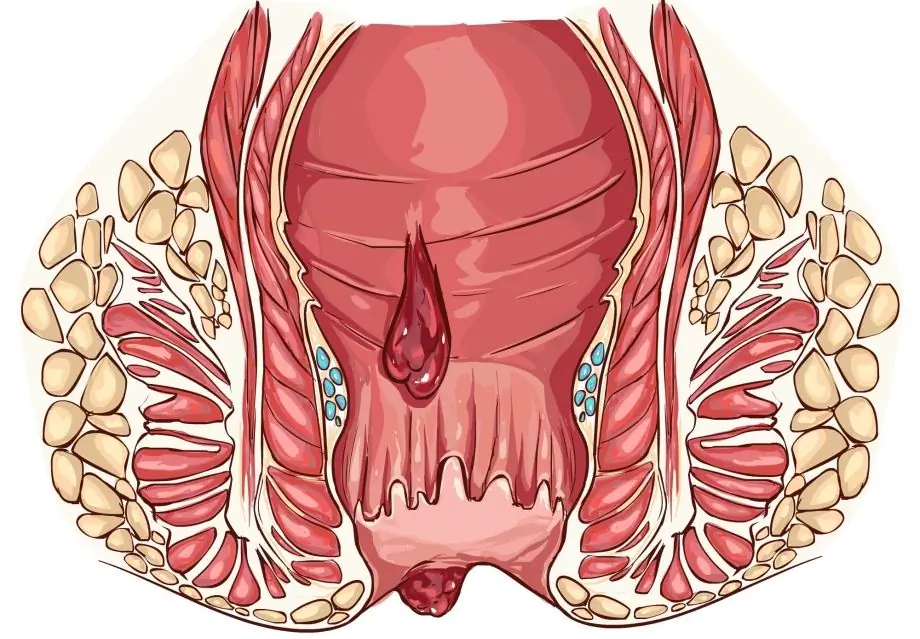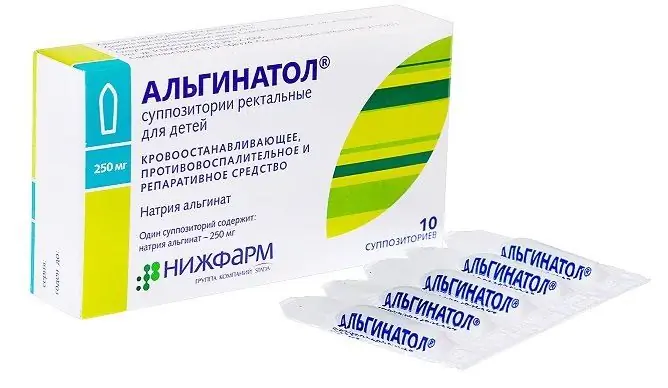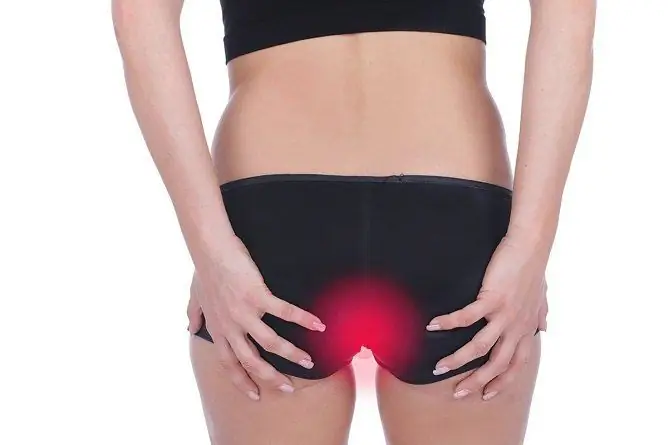- Author Rachel Wainwright [email protected].
- Public 2023-12-15 07:39.
- Last modified 2025-11-02 20:14.
Hemorrhoids in women
The content of the article:
- Causes of hemorrhoids in women and risk factors
- Hemorrhoids in pregnant women
- Forms of the disease
- The severity of hemorrhoids in women
- Symptoms of hemorrhoids in women
- Diagnostics
- Treatment of hemorrhoids in women
- Possible complications and consequences
- Forecast
- Prevention
Hemorrhoids in women is an expansion of the cavernous veins of the choroid plexus of the rectum (hemorrhoidal), accompanied by the formation of internal or external hemorrhoids, characteristic symptoms.

At the initial stage of acute hemorrhoids in women, internal hemorrhoids are involved in the inflammatory process, extremely rarely - external
The rectum is a hollow tubular organ about 15-16 cm long, consisting of 3 layers (mucous, submucous and muscular) and surrounded on all sides by loose fatty tissue of the small pelvis and perineum. At a distance of approximately 2 cm from the anus, in the thickness of the rectum, there is a dentate line, above which the skin of the anorectal zone passes into the mucous membrane.
In the submucosal layer, a few centimeters above the dentate line, there are three hemorrhoidal vascular plexuses that lie along the left, anterior and posterior right walls of the rectum. The structure of the vessels resembles a sponge, due to which they are able to quickly fill with blood and empty just as quickly. Features of the structure and hemodynamics of the choroid plexus provide additional sealing of the anus, contributing to the strong retention of gases and feces, when the blood-filled hemorrhoidal vessels act as a kind of plug for the lower rectum.
The disease is a serious medical and social problem, since, according to various sources, it occurs in every 4-10 inhabitants of the Earth, forming the vast majority of appeals in proctology (up to 40% of the total). Hemorrhoids in women are somewhat less common than in men; with age, the likelihood of the formation of the disease increases.
Causes of hemorrhoids in women and risk factors
The main anatomical and physiological causes of hemorrhoids in women are:
- the predominance of arterial blood filling of the plexus vessels over the venous outflow, which creates the preconditions for the development of stagnation and deformation of the plexus;
- dystrophic-degenerative changes in the longitudinal muscle of the submucosal layer of the rectum and Parks ligaments, which act as a fibromuscular framework for hemorrhoidal vessels;
- microthrombosis of the vascular plexus;
- varicose disease of hemorrhoidal veins;
- traumatic injury to the anal muscles.
As a result of these reasons, the deformation of the corpora cavernosa occurs, their expansion, protrusion into the lumen of the rectum or prolapse from the anus (depending on localization).
Factors contributing to the development of hemorrhoids in women:
- defecation disorders (constipation, excessively dense feces);
- sedentary, sedentary lifestyle;
- systematic long stay in a standing position (production necessity when working in non-mechanized production, in the service sector, in some areas of medicine, etc.);
- overweight;
- adhesive process in the pelvic cavity with involvement of the large intestine in the pathological process;
- autonomic dysfunction;
- hard physical work;
- heart failure;
- stagnation in the portal vein system, leading to an overload of the vessels of the lower body (after cirrhosis, hepatitis, against the background of acute infectious processes, taking certain medications, alcohol abuse, etc.);
- chronic diseases of the pelvic organs (adnexitis, salpingo-oophoritis, cystitis).
Hemorrhoids in pregnant women
The most common factor provoking the development or exacerbation of an existing hemorrhoid in women is pregnancy. According to some reports, the incidence of hemorrhoids in women who did not have a history of childbirth is approximately 5 times less than in those who have given birth. The likelihood of developing hemorrhoids in this case also directly depends on age: pregnancy after 30 years is complicated by hemorrhoids in women on average 3 times more often than in pregnant women at 20 years. Approximately 50% of women who suffer from hemorrhoids during pregnancy have an exacerbation in the first few weeks of the postpartum period.

The most common cause of hemorrhoids in women is pregnancy
During childbirth, the head of the fetus, passing through the birth canal, squeezes the vessels of the small pelvis, which leads to disruption of venous outflow and the formation of stagnation in the bloodstream. The severity of these processes depends on the duration of labor: the longer it is, the more local blood circulation suffers. Hemorrhoids swell sharply, increase in size, become intensely dense, cyanotic. When the head erupts, internal hemorrhoids, with their significant severity, are squeezed out, their rupture is possible. After childbirth, with a gradual contraction of the sphincter of the anus, the internal nodes decrease and adjust on their own, but often, if the contraction of the sphincter passes quickly, these nodes are pinched, and acute hemorrhoids occur.
According to statistical data, hemorrhoids are observed in 7.7% of non-pregnant women, more than 25% of pregnant women and almost half of all puerperas.
Forms of the disease
Depending on the root cause of hemorrhoids in women, there are two forms:
- primary (inherited), developing without connection with the previous pathology;
- secondary, which is a complication of any disease.
According to the duration of the process:
- acute (one-time episode of painful manifestations);
- chronic (long, possibly lifelong, undulating course with periods of remission and exacerbations).
Depending on the clinical picture, hemorrhoids in women can be external (several characteristic swellings located under the skin in direct proximity to the anus) and internal (hemorrhoids are not visualized during external examination, located inside the lumen of the rectum). Internal nodes, if they are not determined by external examination of the anorectal zone, can be detected only by conducting a special examination of the rectum. As a rule, they have a rounded or spindle-shaped shape, are located on a wide base, with a smooth (in the later stages of the disease - bumpy) surface, when pressed, they are easily emptied.
With the addition of a secondary infection, thrombosis of hemorrhoids, their infringement, etc., they talk about complicated hemorrhoids. In the absence of such conditions, hemorrhoids are classified as uncomplicated.
The severity of hemorrhoids in women
The severity (or stage) of hemorrhoids in women is determined depending on the morphofunctional picture, there are 4 stages in total:
- Episodic discharge of scarlet blood from the anus without visible signs of prolapse of hemorrhoids, degenerative-dystrophic changes in the connective tissue-muscular frame are not significantly expressed.
- Hemorrhoids that have fallen out of the anus are visually determined (both with and without bleeding), easily self-adjusting. Dystrophic phenomena progress, but the elasticity of the muscular-fibrous frame is preserved.
- Hemorrhoids that have fallen out of the anal canal require manual reduction, prolapse may be accompanied by bleeding, the muscular layer of the rectum largely loses its elasticity, the mucous membrane is thinned, and there is a tendency to bleeding.
- The prolapse of hemorrhoids is permanent, their reduction is impossible, the supporting apparatus is untenable, muscle tissue is largely replaced by connective tissue.

Stages of hemorrhoids in women
The course of acute hemorrhoids in women is somewhat different from chronic and goes through 3 consecutive stages:
- Thrombosis of external and internal nodes without signs of inflammation.
- Initial inflammatory changes in thrombosed hemorrhoids.
- Thrombosis of nodes, accompanied by inflammation of the subcutaneous fatty tissue of the perianal zone.
Symptoms of hemorrhoids in women
The main signs of hemorrhoids in women with a chronic course make up the characteristic clinical triad of the disease: pain syndrome, protrusion of inflamed hemorrhoids and bleeding, more often associated with the act of defecation.
In the initial stages of the disease, painful symptoms are transient, occur after excessive physical exertion, errors in diet, taking a hot bath, etc.
Bleeding with hemorrhoids in women is the most common symptom of the disease; it occurs in about half of patients. The amount of blood discharged from the anus varies widely: from minor smears on toilet paper to massive bleeding requiring urgent care. The color of the stool in this case is not changed, the blood can be smeared over its surface.
With internal hemorrhoids, patients often complain of blood splashing in a stream, the presence of drops of blood on the walls of the toilet bowl. At the beginning of the act of defecation, blood can be released with coagulated clots, be dark in color if there has been a preliminary accumulation of it in the lumen of the intestine, although more often the color of the released blood is bright scarlet. Bleeding from the anus with hemorrhoids in women is noted in more than 75% of cases.
The prolapse of hemorrhoids (observed in 4 out of 10 patients) in the early stages of hemorrhoids in women is of an episodic nature, the prolapsed nodes are set on their own. As the disease progresses, reduction requires manual assistance, in some cases it is not possible to perform manipulation, the bulging of the elements of the hemorrhoidal plexus becomes permanent. As a rule, the prolapse of hemorrhoids occurs at characteristic points: in the projection of 3, 7 and 11 o'clock on the dial when the patient is supine.
Pain with hemorrhoids in women is constant, dull, aching (in the later stages of the disease) or occurs periodically, in connection with bowel movements. Pain syndrome can be accompanied by discomfort, a feeling of moisture due to excess mucus from the rectum, maceration and itching in the anorectal region. Discomfort, as a rule, is associated with a feeling of heaviness in the perineum, discomfort while sitting, unproductive urge to defecate. Perianal soft tissue edema is also characteristic of acute hemorrhoids in women.

In the later stages of hemorrhoids, a woman is worried about a constant dull, aching pain
At the initial stage of acute hemorrhoids in women, internal hemorrhoids are involved in the inflammatory process, rarely external ones. Intense painful sensations of a sharp, pulsating character arise when walking, lifting weights, trying to sit on a hard surface, especially aggravated by defecation.
Pain syndrome in acute hemorrhoids in women may be accompanied by an increase in body temperature, chills, and a deterioration in general health.
Hemorrhoids fall out when straining, sneezing, coughing, increase in size, swell, expanding the anal canal, and the anus gapes in this case. External nodes become inflamed in isolation in extremely rare cases, but with inflammation of internal structures, they are almost always involved in the pathological process.
Diagnostics
The diagnosis of hemorrhoids in women is established on the basis of objective examination data and the results of instrumental diagnostic methods:
- external examination (swelling and hyperemia of soft tissues in the anus, maceration, the presence of hemorrhoids, connective tissue deformities, etc.);
- digital examination (palpation determination of areas of bulging of the inner wall of the rectum, the state of the anal sphincters, the possibility of independent or digital reduction of the fallen out nodes);
- anoscopy (visual examination of the inner surface of the rectum at a distance of up to 11-12 cm from the anus);
- colonoscopy (endoscopic examination of the colon mucosa);
- sigmoidoscopy (endoscopic examination of the rectum and lower part of the sigmoid colon).

Sigmoidoscopy helps to determine the degree and type of hemorrhoids in a woman
Treatment of hemorrhoids in women
The choice of tactics for treating the disease directly depends on the stage of the pathological process and the severity of clinical symptoms.
Therapy for exacerbation of hemorrhoids in women is symptomatic and is carried out using the following means (both local and systemic action):
- anti-inflammatory drugs;
- analgesics;
- thrombolytic agents;
- local anticoagulants;
- antibacterial or antimicrobial drugs in order to prevent secondary infection (if there are signs of a violation of the integrity of the mucous membrane, skin);
- phlebotonics;
- drugs that reduce straining;
- laxatives.
An obligatory component of the conservative treatment of hemorrhoids in women is adherence to a special diet (high fiber content in the food consumed, plenty of water, osmotically active drinks, refusal to abuse alcoholic beverages, spicy, spicy, fatty foods) and lifestyle modification: a rational mode of physical activity, changing the food stereotype, careful observance of the hygiene of the anal area.

In the later stages of hemorrhoids, surgical treatment is recommended - hemorrhoidectomy
In addition to drug therapy, non-pharmacological methods of treatment are used in the treatment of hemorrhoids, both radical surgical (hemorrhoidopexy or hemorrhoidectomy) and minimally invasive:
- infrared photocoagulation;
- sclerosing of damaged vessels;
- the imposition of ligatures on hemorrhoids with latex rings;
- ligation of the vessels of the hemorrhoidal plexus under the control of ultrasound Doppler measurements;
- bipolar coagulation.
Possible complications and consequences
Complications of hemorrhoids in women can be:
- thrombosis of hemorrhoids;
- necrotization of hemorrhoids;
- anal fissure;
- accession of a secondary infection;
- proctitis;
- paraproctitis;
- rectal fistula;
- massive bleeding.
Forecast
With timely diagnosis and qualified treatment, the prognosis is favorable. A prerequisite for reducing the frequency of exacerbations and reducing the severity of the chronic process is compliance with food recommendations, changing the lifestyle.
Prevention
- Compliance with a diet high in fiber, fluids.
- Performing physical exercises aimed at improving microcirculation in the pelvic cavity, strengthening the muscle frame.
- Careful adherence to the hygiene of the anorectal zone.
- Avoiding prolonged straining during bowel movements.
- Avoiding local hypothermia.
- Refusal to stay in a sitting position for a long time.
YouTube video related to the article:

Olesya Smolnyakova Therapy, clinical pharmacology and pharmacotherapy About the author
Education: higher, 2004 (GOU VPO "Kursk State Medical University"), specialty "General Medicine", qualification "Doctor". 2008-2012 - Postgraduate student of the Department of Clinical Pharmacology, KSMU, Candidate of Medical Sciences (2013, specialty "Pharmacology, Clinical Pharmacology"). 2014-2015 - professional retraining, specialty "Management in education", FSBEI HPE "KSU".
The information is generalized and provided for informational purposes only. At the first sign of illness, see your doctor. Self-medication is hazardous to health!






